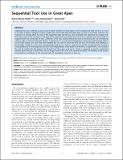Files in this item
Sequential Tool Use in Great Apes
Item metadata
| dc.contributor.author | Martin-Ordas, Gema | |
| dc.contributor.author | Schumacher, Lena | |
| dc.contributor.author | Call, Josep | |
| dc.date.accessioned | 2014-04-24T15:01:03Z | |
| dc.date.available | 2014-04-24T15:01:03Z | |
| dc.date.issued | 2012-12-26 | |
| dc.identifier | 104082965 | |
| dc.identifier | 75c7483a-07e5-4d91-ac85-1f052b968ffc | |
| dc.identifier | 000313618800046 | |
| dc.identifier | 84871568246 | |
| dc.identifier.citation | Martin-Ordas , G , Schumacher , L & Call , J 2012 , ' Sequential Tool Use in Great Apes ' , PLoS One , vol. 7 , no. 12 , 52074 . https://doi.org/10.1371/journal.pone.0052074 | en |
| dc.identifier.issn | 1932-6203 | |
| dc.identifier.other | ORCID: /0000-0002-8597-8336/work/37477791 | |
| dc.identifier.uri | https://hdl.handle.net/10023/4601 | |
| dc.description.abstract | Sequential tool use is defined as using a tool to obtain another non-food object which subsequently itself will serve as a tool to act upon a further ( sub) goal. Previous studies have shown that birds and great apes succeed in such tasks. However, the inclusion of a training phase for each of the sequential steps and the low cost associated with retrieving the longest tools limits the scope of the conclusions. The goal of the experiments presented here was, first to replicate a previous study on sequential tool use conducted on New Caledonian crows and, second, extend this work by increasing the cost of retrieving a tool in order to test tool selectivity of apes. In Experiment 1, we presented chimpanzees, orangutans and bonobos with an out-of-reach reward, two tools that were available but too short to reach the food and four out-of-reach tools differing in functionality. Similar to crows, apes spontaneously used up to 3 tools in sequence to get the reward and also showed a strong preference for the longest out-of reach tool independently of the distance of the food. In Experiment 2, we increased the cost of reaching for the longest out-of reach tool. Now apes used up to 5 tools in sequence to get the reward and became more selective in their choice of the longest tool as the costs of its retrieval increased. The findings of the studies presented here contribute to the growing body of comparative research on tool use. | |
| dc.format.extent | 15 | |
| dc.format.extent | 585237 | |
| dc.language.iso | eng | |
| dc.relation.ispartof | PLoS One | en |
| dc.subject | CALEDONIAN CROWS | en |
| dc.subject | TASK | en |
| dc.subject | SELECTIVITY | en |
| dc.subject | MONKEYS | en |
| dc.subject | GORILLA | en |
| dc.subject | SOLVE | en |
| dc.title | Sequential Tool Use in Great Apes | en |
| dc.type | Journal article | en |
| dc.contributor.institution | University of St Andrews. School of Psychology and Neuroscience | en |
| dc.contributor.institution | University of St Andrews. Centre for Social Learning & Cognitive Evolution | en |
| dc.identifier.doi | 10.1371/journal.pone.0052074 | |
| dc.description.status | Peer reviewed | en |
This item appears in the following Collection(s)
Items in the St Andrews Research Repository are protected by copyright, with all rights reserved, unless otherwise indicated.

